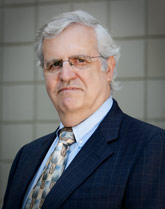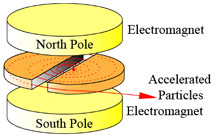

Friday - August 7, 2009
SLAC Today is
available online at:
http://today.slac.stanford.edu
In this issue:
From the Acting Director of SSRL
Nominees Sought for 2009 "Globie" Awards
Word of the Week: Cyclotron
 |
 |
|
Friday - August 7, 2009 |
From the Acting Director of SSRL With the growth of photon science at SLAC, I thought it would be interesting to discuss the Stanford Synchrotron Radiation Lightsource's research portfolio and how it has been changing over the past several years. However, first I would like to give a short review of the past year. 2009 has been a great year for SSRL with an average uptime of 99 percent (with less than one week to go in the run) and excellent user satisfaction. This level of uptime and user satisfaction always amazes me when I reflect that this is a 24/7 operation. Not only must the accelerator operate flawlessly, the beam lines must be made ready on a daily basis for the rapidly changing sets of users that cycle through the lab. In many respects, this is much like a production line where dedicated support staff are critical to the smooth operation of the program, whether it is making sure that the SPEAR3 storage ring runs day in and day out, setting up for a new experiment or replacing a failed piece of equipment on short notice. Although the SSRL annual shutdown starts on August 10, everyone will be busy in a different ways with maintenance and upgrade activities for the next few months until the user run cycle starts again for another nine months. Other milestones we have met this year include the finishing of the SPEAR3 beamline upgrade project, with the completion of three stations on Beamline 4 and successful routine user operation at 200 mA in top-off mode. This mode of operation was the result of hard work from the accelerator, beamline and Radiation Physics Department staff in close cooperation with the Department of Energy Site Office. Ultimately, this mode of operation will allow us to deliver stable beams at nearly constant current at up to 500 mA. Finally, DOE has come through this year with almost 10 million dollars to enable SSRL to undertake badly needed infrastructure and beamline upgrade projects. Read more...  Nominees Sought for 2009 "Globie" AwardsEvery year SLAC recognizes employees who make the lab a better place to work, through the Employee Recognition "Globie" Awards. Now is the time to nominate someone who demonstrates SLAC's Core Values and promotes respect, integrity, diversity and citizenship in the workplace. You may nominate up to three people for a Globie award by filling out the online nomination form. The deadline for nominations is August 21. This year, 20 recipients will be chosen for the Globie award, with no more than five recipients from each directorate. All members of the SLAC staff are eligible for the award, except for top level management. Individuals may not receive an award in consecutive years. In addition to receiving recognition from their peers for being good citizens of SLAC, awardees will be given the prestigious Globie statuette, a certificate of recognition and a letter from the Director in the employee's personnel file. The 20 awardees selected for this year's award will also have their pictures on SLAC's Wall of Fame in Building 41 and will attend a celebratory luncheon at SLAC.  (Image: Jefferson Lab.)
Word of the Week: CyclotronA cyclotron is an early accelerator design that propels charged particles in spiraling circular paths. Typically, the devices consist of two d-shaped electrodes sandwiched between a pair of electromagnets. The magnetic force traveling between the two magnets causes charged particles in the electrodes to travel in a circle, while an alternating electric field between the electrodes causes the particles to accelerate. As the velocity of the particles increases, so does the size of the circle, and the particles spiral outward toward the edges of the electrodes. The particles eventually reach an exit point on the electrodes, and zoom away in a straight line from the device. Invented in 1929 by Ernest Lawrence, cyclotrons are still used in some types of high-energy physics experiments and also have numerous medical applications, providing sources of radiation for cancer treatment and for positron emission tomography. |
Events
Access (see all)
Announcements
|
|
| | ||
|
|
||
 <%
Response.AddHeader "Last-modified", getArticleDate()
'Response.AddHeader "Last-modified","Mon, 01 Sep 1997 01:03:33 GMT"
'Monday, December 06, 2010
%>
<%
Response.AddHeader "Last-modified", getArticleDate()
'Response.AddHeader "Last-modified","Mon, 01 Sep 1997 01:03:33 GMT"
'Monday, December 06, 2010
%>View online at http://today.slac.stanford.edu/. |
||